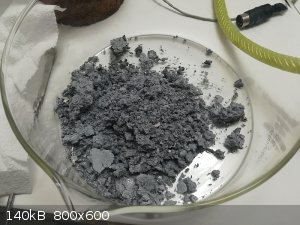nimgoldman
Hazard to Others
  
Posts: 303
Registered: 11-6-2018
Member Is Offline
|
|
Processing aluminium waste containing mercury
I am now researching processing waste from aluminium amalgam reduction. Usually pieces of aluminium foil are amalgamated in anhydrous alcohol, then aqueous acid and the organic compound to
reduce are added to start the reaction, where mercury acts as a catalyst. Here aluminium is oxidised and the organic compound reduced.
The reaction mixture was then filtered through a thin bed of Celite with the aid of vacuum, the filter cake was washed with water and now it contains
mostly aluminium powder, pieces of unreacted aluminium, pieces of the amalgam and a little bit of Celite.
Now I can take a shortcut, mix the solid waste with sulfur and store it as "mercury waste" until enough is collected to be sent for further
processing.
However, is there a practical way to process the waste in the lab? The amount of mercury is only catalytic in the 100s milligrams range.
My first guess is to dissolve all the Al with alkali metal hydroxide (NaOH or KOH) to form soluble sodium aluminate. How will that affect the amalgam?
I also plan to experiment with gallium amalgam for future reductions, which is more environmentally friendly, but gallium is much more expensive than
mercury and hence it might be worth processing the waste to recover the precious gallium for reuse. I assume the waste processing would be similar.

|
|
|
fusso
International Hazard
    
Posts: 1922
Registered: 23-6-2017
Location: 4 ∥ universes ahead of you
Member Is Offline
|
|
Alkali hydroxides wont dissolve Hg. So all Al will dissolve leaving liquid Hg behind, but to remove the final traces of Al from a small drop of Hg
takes hours to days.
For Al&Ga separation, Nurdrage already have 2 ways:
https://www.youtube.com/watch?v=sUSjWfBBu2Y
https://www.youtube.com/watch?v=NwLgL1dGuSM
|
|
|
nimgoldman
Hazard to Others
  
Posts: 303
Registered: 11-6-2018
Member Is Offline
|
|
Thanks I will check out the NurdRage's videos.
The purification of Hg probably won't be necessary if it will be reused for the same purpose (i.e. being amalgamated with Al anyway).
The purification of Hg would be conducted only after enough crude Hg is collected.
My goal was rather to reduce the amount of hazardous waste and be able to reuse Al and Hg. Unfortunately, I don't own a kiln, but with it, maybe the
Al powder can be melted (after sufficient purification) without much toxic fumes and made into buttons.
|
|
|
karlos³
International Hazard
    
Posts: 1520
Registered: 10-1-2011
Location: yes!
Member Is Offline
Mood: oxazolidinic 8)
|
|
You can probably also use some seignette salt(potassium sodium tartrate) to dissolve the aluminium I think.
A tip, using gallium activated aluminium will probably not be satisfying, or yielding anything at all on your chosen substrate... you aren't the first
one I've heard of trying to do so and likely won't be the last, but I hope at least one of those who get spared from being disappointed by that
attempt.
I don't know why, but it just doesn't work similar well(or at all) with that reaction, I have never read about a successful attempt of it ever, not at
the hyperlab even, and neither here(I think Melgar was trying it?).
Better save your time and reagents, at least that is my opinion on the "Al/Ga"...
Next time you're better off to use something that will surely work and be a satisfying experience, I would really recommend the NaBH4/CuCl2 reduction
for that 
|
|
|